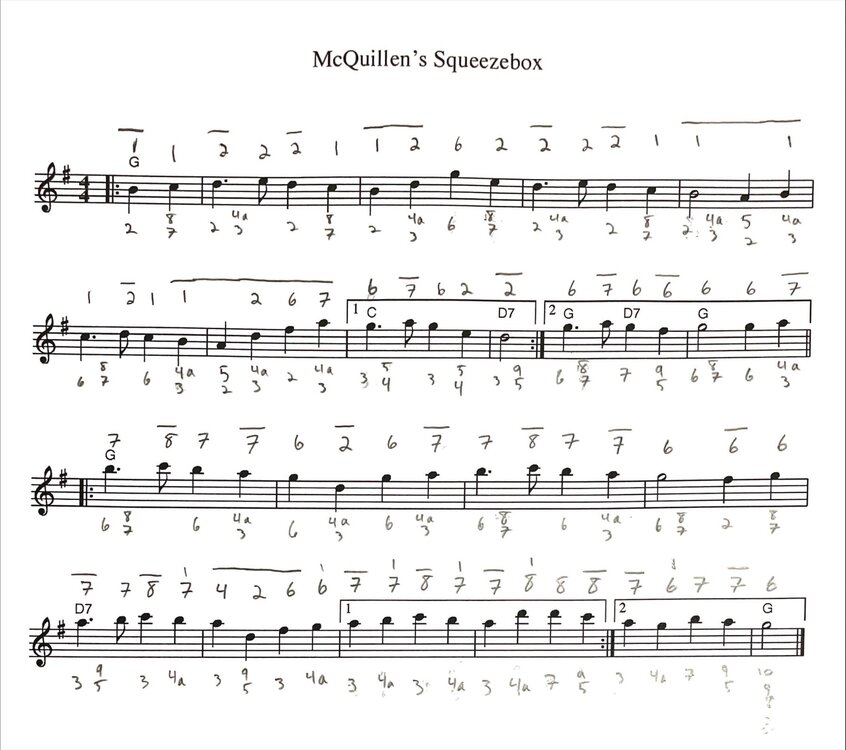-
Posts
97 -
Joined
-
Last visited
Everything posted by Owen Anderson
-

EasyABC can play the concertina!
Owen Anderson replied to Don Taylor's topic in General Concertina Discussion
My solution is to use abc2midi to render my ABCs to a MIDI file, and then play them back with VLC which supports sound fonts for its MIDI player (though the setting is quite buried). I have had a lot of success using it to "preview" tunes before I attempt to learn them on Anglo. -

Why are accordions relatively so cheap?
Owen Anderson replied to Martin Essery's topic in General Concertina Discussion
For what it's worth, my experience with a McNeela Wren as a starter instrument (coincidentally also upgrading to a Marcus) was also similar to what you encountered with the Rochelle. These issues seem to be unfortunately common to mass produced entry level concertinas. -
Kimric Smythe of Smythe's Accordion Center gave me a sticker made from this historic magazine cover, and I absolutely love it. I have no idea why the American GI has a concertina (or a monkey on his shoulder), but the energy is just great.
-

Concertinas go Bush series
Owen Anderson replied to Steve Wilson's topic in Concertina Videos & Music
I've been greatly enjoying this series! -

An old American Folksong with Concertina!
Owen Anderson replied to M and T Concertina's topic in Concertina Videos & Music
Interestingly, the chorus that you're singing is totally different than the version I learned as a child in the US. Yet your audience appears to know and expect your version. I wonder if this is an Australian variant on it? -
mcquillen_g.pdf Here's a second attempt at tabbing the chords for this tune. I stuck with the chords as written for now, but the D7 chords definitely gave me trouble in particular. I had to use inversions in a number of places to make it work out. I'm thinking I should revisit the melody line to switch the bellows direction in a few key spots. Feedback welcome.
-
Thank you for the feedback on this! Just to be clear, I didn't create the chord progression here. I took it from the sheet music provided by the aforementioned YT channel. I only did the button arrangement for Anglo. I definitely don't know enough to make my own chords for a tune! I've been busy recently, but I'll report back once I have time to work on a revised button arrangement.
-
(4) That's what I'm using VSCode + abcjs for, getting a live preview as I write it out by hand. The bar lines in the lyrics lines are there to help me when hand-writing it, to make sure I don't accidentally skip a note in one of the lines. I also pad out the overbar line with spaces to make everything line up nicely. I've toyed with formatting it such that the notes and the tablature are forcibly aligned, but it didn't really work out.
-
Thank you for the feedback! My chord theory is weak, so this is great feedback. Just to make sure I understand, what you're saying is that I should be playing the Gmaj chord with the G as the lowest note? Any other feedback on the chordal arrangement appreciated, I'm very much still learning here,
-
(1) If I were inventing tablature from scratch, I agree that ABT-style seems more intuitive. But I'm already fairly invested in learning gcoover-style via his books, so I might as well stick with it. (2) I'm actually quite interested in the chord technical challenge of optimizing chordal arrangements. It's similar to some of the constraint optimization problems I've encountered in my engineering work. But ingesting the tunes is a big hurdle. (4) I use the abcjs plugin for Visual Studio Code when hand-writing ABC code to get a live preview, so getting that bug fixed will save me a lot of futzing.
-
(1) I got the lyrics model from someone on this forum. I actually thought it might have been you! (2) I’m doing it by hand. I have thought about writing a program for it (I think finding good chord arrangements would be an interesting optimization problem), but writing a parser for ABC seems like a nightmare. (4) I have not experimented with that. One thing I did notice is that abcjs does not support escaped underbars, which messes up the rendering of the push/pull bars. I reported a bug upstream and it looks to be fixed in the next release!
-
Here's my hand-annotated (gcoover-style) attempt at arranging the chords for 30b Anglo. Feedback appreciated, as the most tricky chord arrangement I've attempted so far.
-
Note that there's a jump from pull-R7 to pull-R2 in the last line. I'm experimenting with changing the pull-R7 to push-R2a so that I can reach it with my index finger.
-
Arrangement of McQuillen's Squeezebox for C/G Anglo in G, using a variant of the melody from the Free Fiddle Lessons Youtube channel. gcoover-style tablature. Transposed from D to G to try to get the melody mostly on the right hand. I'd like to incorporate fingering for the chords in the future. mcquillen_g.pdf
-

COMPARISON ROCHELLE-2 V MARCUS DELUXE
Owen Anderson replied to Martin Essery's topic in General Concertina Discussion
My experience acquiring a used Marcus after initially learning on a McNeela Wren is very similar to your experience here.- 1 reply
-
- 1
-

-

Changing oom-pah to match melody
Owen Anderson replied to Owen Anderson's topic in Teaching and Learning
I wasn't actually proposing changing the tones of the chord, just the order of play. So I while I would be moving the c to the 1st beat, it would not be the lowest note of the chord. To make it an inverted chord, I think I would need to make the oom "C," instead of c. -
I'm curious if there is any historical record of association between hoboes (particularly American tramps & bums) and concertinas. I think of the heyday for hoboes as spanning from the 1890s to the 1930s, which would have overlapped with the later part of concertina popularity in North America. And as relatively portable instruments, and ones similar to the very hobo-associated harmonica, it seems plausible that they could have seen some use. The time period is a little late - the concertina's popularity was in decline by 1910 - but if anything I would have thought that cheaply available pawnshop instruments might *increase* usage amongst the notoriously cheap hobo population. I checked Dan Worrall's book and couldn't find any reference to hobo usage of concertinas, but maybe someone else has heard of it? Conversely, if it didn't happen, any theories why not?
-
Another, perhaps basic, question inspired by trying to arrange for Anglo. I'm working on an Anglo arrangement starting from a melody + guitar chords, and running into a measure that is giving me trouble. The bar is a-a-c'-c', accompanied by a Fmajor chord. I've arranged most of the song with straight forward oom-pahs, but here I'm finding that the normal pah (A/c) doesn't sound great against the c' in the 3rd count of the measure. I'm guessing this is because of the octave correspondence between the c and the c'. So I'm considering rearranging the oom-pah to put c on the 1st count, and F/A on the 3rd count of the measure. Off the bat this sounds somewhat better to me, but the 1st beat sounds "thin", since it's two high notes. Is this... a thing? Is there a better solution?
-
Could someone link the actual FB post for the Cornell collection?
-
A while ago I got to try out a Blackbird Clara ukulele, which is made from eKoa, a flax-based composite material that looks and sounds a lot like wood, but can be molded like carbon fiber. To cut to the chase, it sounded absolutely gorgeous. The eKoa allows a lot of design features on the ukulele that just wouldn't be possible with traditional wood construction. I was recalling the experience this morning, and the idea occurred to me that perhaps some aspiring concertina maker could find interesting applications for this material.
-
I'd like to figure out an Anglo arrangement for the French-Canadian voyageur song "En Roulant Ma Boule". I was inspired by the recording that is accompanied with an accordion, so it seems plausible to arrange for a concertina as well. Here's a transcription of the melody in ABC, with some guitar chords that I got from the internet. Unfortunately, the chords don't sound that good to me (at least when played with back via a MIDI player with a concertina sound font), but I'm not competent to figure out what's wrong. The accordion player in the recording doesn't seem to be doing normal oom-pah accompaniment anyways. X:1 T:En Roulant Ma Boule L:1/8 M:6/8 K:D "D" f2 e d2 A | "G" BAB "D" A3 | "D" f2 e d2 A | "A7" (B2 c) "D" d3 | "D" f2 e d2 A | "G" BAB "D" A3 | "D" f2 e d2 A | "A7" (B2 c) "D" d2 A | "D" d2 e d2 A | "G" B2 B "D" A3 | "D" d2 e d2 A | "G" B3 "D" A2 A | "D" d2 e d2 A | "G" B2 B "D" A3 | "D" d2 e d2 A | "G" B3 "D" A2 A | "D" d2 d "A7" e2 e | "D" f2 d "A7" e2 e | "D" f2 d "A7" e2 e | "D" fed "A7" e3 | "D" f2 e d2 A | "G" BAB "D" A3 | "D" f2 e d2 A | "A7" (B2 c) "D" d3 |]
-

Help with acquiring muscle memory?
Owen Anderson replied to Annelies's topic in Teaching and Learning
Any resources you recommend? When I tried to search for stuff, I invariably get content that either assumes I have no idea what a staff is, or that I already have 5 years of music theory knowledge and am ready to company a symphony. What's the middle ground content for someone who knows the basics of reading music and wants to learn some more theory? -

Looking for Anglo teacher in San Francisco Bay Area
Owen Anderson replied to Owen Anderson's topic in Teaching and Learning
I've seen passing reference to this meetup on the ICA website. Do you know where I can find any more info? -
I'm looking for someone to help me improve on Anglo in the SF Bay Area. I'm a relative beginner (~5 months in, but practicing almost every day), interested in English and American folk music, particularly harmonic style. I'm looking for someone who can give me feedback and pointers to help me improve. I'd also appreciate any other suggestions of any local groups or resource to help me learn.
-
That's really interesting. Do you know how the pressure sensing works? I've thought about trying to build a MIDI anglo, but was never sure how the pressure sensing would work.




